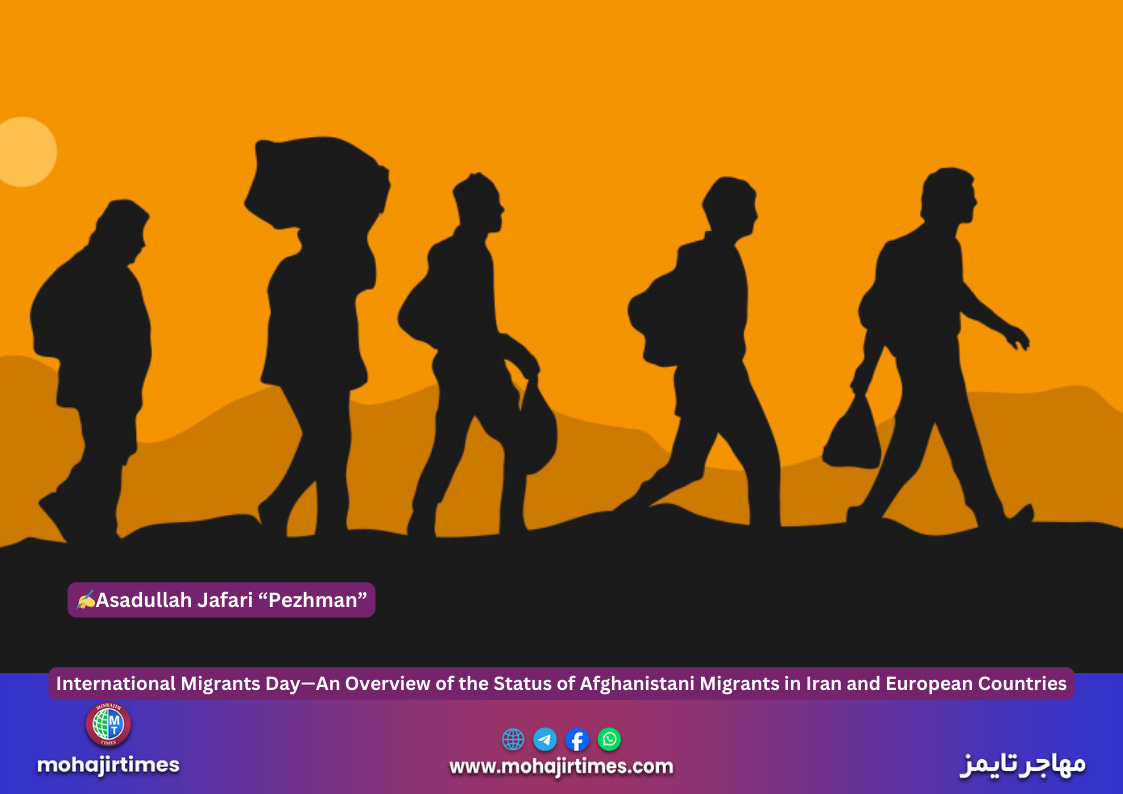International Migrants Day—An Overview of the Status of Afghanistani Migrants in Iran and European Countries
Only through global solidarity and support can be end the problematic plight of migrants and refugees and build a better world for all migrant humans
By: Asadullah Jafari “Pezhman”
International Migrants Day serves as an opportunity to review the conditions and rights of millions of migrants who have been displaced worldwide in search of safety and better life opportunities. In 2024, with the increase in crises and conflicts across various regions, migration remains one of the greatest social and humanitarian challenges. Afghan migrants, due to the ongoing instability and crisis in their home country, represent one of the largest migrant groups living in different countries, including Iran and European nations.
This essay-article explores the status of Afghan migrants in host countries and the challenges they face as they try to build new lives. Every year, December 18th is celebrated as World Migrants Day around the world, a day designated by UNESCO to honor the efforts, dignity, and human rights of migrants around the world.
In 2024, migration continues to be a complex and challenging issue that countries worldwide are grappling with. According to reports from international organizations, including the United Nations High Commissioner for Refugees (UNHCR), over 104 million people worldwide have been forced to leave their homes and countries. Among them, Afghanistani migrants form one of the largest groups due to the ongoing instability in Afghanistan.
The Situation of Afghanistani Migrants in European and Western Countries
In recent years, European and Western countries have been home to a significant number of Afghan migrants. After the Taliban’s return to power in 2021, the resulting economic, security, and humanitarian crises led thousands of Afghan citizens to seek refuge in various countries. Germany, France, the United Kingdom, and the United States have adopted extraordinary measures to accommodate Afghan migrants in response to the emergency situation in Afghanistan.
However, the acceptance of these migrants now faces serious challenges, such as lengthy asylum processes, poor living conditions in refugee camps, and concerns regarding social integration. European countries have also faced criticism for not taking sufficient actions to assist the Afghan people within Afghanistan. Moreover, some European countries have resisted accepting Afghan migrants, imposing stricter limitations on their acceptance. Among these challenges, the situation of Afghanistani women and children is particularly concerning. Many Afghan women fleeing Taliban violence face additional hardships in host countries, including limited access to fundamental rights such as education, discrimination, health services, safety, and so on.
The Situation of Afghanistani Migrants in Iran
Iran is one of the countries hosting the largest number of Afghan migrants globally. According to official statistics from the Refugee Affairs Organization, more than 3 million Afghans live in Iran, many of whom have entered the country illegally. Afghan migrants in Iran face significant challenges, living in harsh economic, legal, and social conditions, with limited access to healthcare, education, and employment services. In recent years, particularly following the changes in Afghanistan and the increasing economic pressures, Afghan migrants have been severely impacted. Many continue to live in a legally uncertain status and lack full citizenship rights. Meanwhile, due to Iran’s internal economic challenges and the pressures of international sanctions, the country is unable to provide adequate services to its migrant population.
The Economic Impact of Migrants on Host Countries, Especially Iran
Migration always has dual economic effects on host countries, depending on factors such as the number of migrants, their skill sets, the host country’s economic conditions, and migration policies.
Cheap and Complementary Labor Force
Migrants, particularly those from developing countries moving to developed ones, are often considered a cheaper labor force than local workers. This labor can be beneficial to various industries, especially in construction, agriculture, and services. Afghan migrants in Iran have played an essential role in these sectors. In regions like eastern Iran (such as Sistan and Baluchestan and Khorasan Razavi, Kashan, Qom, Tehran, and so on), many Afghan migrants work in agriculture, animal husbandry, and handicrafts, often for meager wages.
Increased Demand for Goods and Services
Migrants naturally increase the demand for goods and services, which can help boost sectors of the economy that are reliant on migrants, such as housing, transportation, healthcare, education, and public services. In Iran, the sizeable Afghan migrant population has led to increased demand in these areas, especially visible in the housing market and public services.
Innovation and Entrepreneurship
Migrants can also introduce innovative ideas and entrepreneurial methods to the host country. Many migrants seek new ways to generate income, which can lead to economic growth and innovation in host countries. In some countries, Afghan migrants have also ventured into entrepreneurship, although this process is more restricted in Iran due to the lack of clear, supportive laws and national legal limitations.
Negative Impacts of Migrants on Host Country Economies and Pressure on Limited Resources
One of the main challenges of accepting migrants is the pressure on the host country’s limited resources. In Iran, Afghan migrants, due to their large numbers and complex legal status, are under economic strain. This pressure can increase competition for limited resources such as jobs, housing, and public services. Especially when Iran’s economy is facing numerous difficulties, the increase in migrant numbers may place a heavier burden on the government and welfare systems.
Impact on Unemployment and Wages
Migration can increase unemployment among local workers, especially in low-skilled and informal sectors. Migrants may work for lower wages, which can, in turn, depress wages in certain parts of the labor market. This effect is particularly noticeable in informal sectors such as construction and services in Iran. Many Afghan workers are employed in these fields, increasing competition for Iranian workers.
Financial Burden on Welfare Systems
Iran, already facing limited resources due to sanctions and economic difficulties, must incur additional costs to support migrants. These costs include providing healthcare, education, and social services to migrants, which can be challenging in the current economic climate. However, due to Iran’s economic conditions, it may not be able to provide adequate welfare services to migrants, potentially leading to social dissatisfaction among the migrant population.
Impact of Afghan Migrants on Iran’s Economy
Afghan migrants in Iran, as one of the largest migrant groups, have had multiple effects on the country’s economy. According to statistics, the Afghan migrant population in Iran exceeds 3 million, including those who are living legally or illegally. These migrants have directly and indirectly influenced the country’s economy.
Labor Force in Various Sectors
Afghanistani migrants serve as cheap labor, especially in agriculture, services, and industry. Many of these migrants work in hard labor with low wages, contributing to producing and providing specific goods and services in the country.
Impact on the Housing Market
One of the most visible effects of the Afghan migrant presence in Iran is the increased demand for housing. These migrants often live in marginalized areas of cities, contributing to pressure on the housing market, especially in densely populated and impoverished regions. This situation can lead to rising rental prices and make living conditions more difficult for low-income individuals.
Economic and Social Challenges
However, the presence of Afghan migrants in Iran can also create challenges for the Iranian economy. The pressure on financial resources, public services, and employment in some sectors could impact the quality of life for Iranian citizens. Additionally, Afghan migrants, due to their unstable legal status and social problems, may face severe discrimination and social issues, which could result in unrest and pressure on the social system.
Xenophobia Against Afghanistani Migrants in Iran: Impacts and Legal Basis
Xenophobia is a phenomenon that can mainly be observed in societies with high numbers of migrants from neighboring countries. Also, In Iran, Afghan migrants, despite historically constituting a large portion of the migrant population, have always faced discrimination and difficulties. These discriminations are not only social and cultural but, in some cases, are legally embedded.
Impacts of Xenophobia on Afghan Migrants in Iran and Social and Economic Discrimination
Xenophobia in Iran has led to social and economic discrimination against Afghan migrants. Many of these migrants, due to their unclear legal status, are vulnerable to violence, workplace discrimination, and social exclusion. Since many Afghans live illegally in Iran or enter with temporary work or tourist visas, they often face significant challenges in finding work and are deprived of fundamental rights such as access to healthcare, education, and labor rights. These discriminations also manifest socially, especially in media, social media, and public spaces. In some instances, Afghan migrants are seen as “Foreigners” or “Alien Nationals” (Attba-e Biganeh), which diminishes their sense of social and psychological security.
Low Self-Esteem and Feelings of Rejection
Afghan migrants, due to discriminatory and xenophobic behavior, may experience social rejection. This feeling can negatively affect their mental health, motivation, and social interactions. Many Afghan migrants struggle with issues related to their cultural and social identity, as they face not only economic difficulties but also social and cultural sensitivities, which can lead to decreased self-confidence and feelings of alienation.
Security Concerns
Xenophobia and negative attitudes towards Afghan migrants can exacerbate security concerns and social violence. In certain regions of Iran where there is a high concentration of Afghan migrants, this may lead to collective or individual violence. Such violence could include physical assaults, verbal abuse, or even acts of violence by specific groups against Afghan migrants.
Legal Basis of Xenophobia Against Afghanistani Migrants in Iran
The legal basis for xenophobia against Afghan migrants in Iran primarily stems from the migrants’ legal status. Unlike some other countries with clear refugee or immigration policies, Iran hosts millions of Afghan migrants, many of whom live illegally or without official documentation. Some Afghan migrants entered Iran with temporary visas but stayed due to economic difficulties or political changes in Afghanistan.
This uncertain legal status means that Afghan migrants are not only deprived of many social, labor, and economic rights but are also at risk of deportation and further pressures. This legal situation creates a foundation for xenophobia, as the host society, particularly certain groups, perceives Afghan migrants as illegally present in their country, justifying discriminatory behaviors as lawful due to their ambiguous legal status.
Looking Ahead and Conclusion:
Overall, the status of migrants in 2024 reveals that fundamental challenges remain. Given the humanitarian and political crises occurring in many countries around the world, including Afghanistan, there is a growing need for increased international support and more humane migration programs. Host countries must take further steps to integrate migrants and uphold their human rights. On International Migrants Day, it is crucial to focus on these individuals’ difficult circumstances and work towards creating a world with equal opportunities for all. It is hoped that, in the near future, the rights of Afghan migrants and refugees in various countries, particularly in Iran, will receive better attention from governments, national institutions, and international organizations and that better living conditions will be provided for them.
International Migrants Day should serve as an opportunity for host countries to reaffirm their commitment to human rights, support migrants and refugees, and create favorable conditions for their integration into society. Only through global solidarity and support can be end the problematic plight of migrants and refugees and build a better world for all migrant humans.







